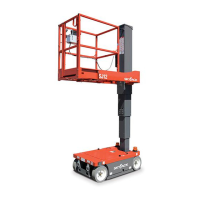23
Mast inspections Section 1 – Scheduled Maintenance
1.7 Mast inspections
1
Mast assembly (B, C)
▪
B - Frequent/periodic/pre-delivery Inspection
▪
Make sure the mast assembly shows no signs
of visible damage, deformation, or cracks in
the weldments.
▪
Make sure the lift cylinder is properly secured,
there are no loose or missing parts and there
is no sign of damage.
▪
Make sure there are no loose or missing
fittings and there is no sign of hydraulic leaks.
▪
Mast lubrication is an annual requirement as
a minimum. Based on machine use, the mast
may need to be lubricated more frequently.
Examples include:
▪
It is used in very dusty environments.
▪
The mast does not move freely.
▪
Refer to 5.8 Mast Lubrication Procedure for the
mast lubrication procedure.
▪
C - Annual Inspection
▪
Lubricate the mast.
▪
Refer to 5.9 Mast Lubrication Procedure for the
mast lubrication procedure.
2
Chains (C)
▪
Make sure the chains are correctly attached.
▪
Make sure the bolts are tight.
▪
Make sure there are no loose or missing parts.
▪
Make sure there is no visible damage.
▪
Refer to 5.11 Mast Chain Visual Inspection for a
mast chain inspection.
3
Rollers (B)
▪
Make sure the rollers are correctly attached and
not obstructed.
▪
Make sure there are no loose or missing parts.
▪
Refer to 5.10 Mast Roller Inspection/Maintenance
for roller and roller mount inspection details and
instructions.
4
Control Cables (B)
▪
Make sure the cables are secure.
▪
Make sure there is no visible damage.
5
Wear Pads (B)
▪
Make sure the bolts are tight.
▪
Make sure there are no loose or missing parts.
▪
Make sure there is no visible damage.
6
Tilt sensor (B)
▪
Make sure the tilt sensors are correctly
attached and there is no visible damage.
1
5
2
6

